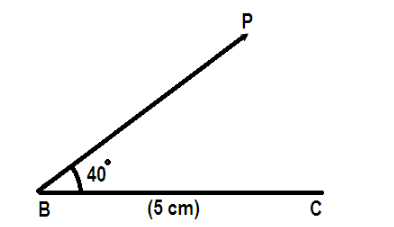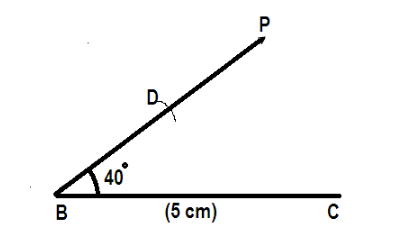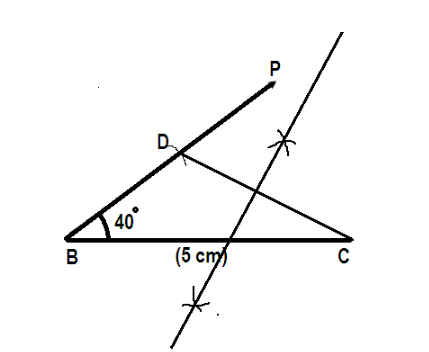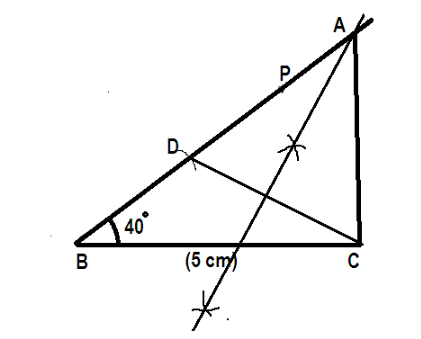
Construct a triangle ABC in which BC= 5 cm, AB- AC= 2.8 cm and $ \angle B = {40^ \circ } $ .
Answer
455.4k+ views
Hint: A triangle is a three sided quadrilateral and to construct a triangle one needs to draw a line segment and suppose it to be the base of the triangle. To construct a triangle one needs a protractor or a compass, a ruled scale.
Complete step-by-step answer:
Since we have been given the length of a line segment BC as 5 cm. let us draw a line segment BC using the ruler and suppose it to be the base of the triangle.

We have the measure of angle B, therefore using the protractor we will make the $ \angle PBC $ of measure equal to the $ \angle B = {40^ \circ } $ and extend the ray .

Now from the ray AP cut off the line segment BD equal to ‘l’ which is the given difference of AB- AC = 2.8 cm. Stretch your compass 2.8 cm and put the needle of the compass at B cut off BD from the ray AP.

Now join C and D. Construct the perpendicular bisector of CD meeting BP at C where the perpendicular bisector is drawn by drawing an arc on both the sides of DP with the help of compass taking C and D as centres.

Now extend the ray BP such that it meets the perpendicular bisector at the point A and then join A and C to draw the complete triangle ABC.

Hence this is the triangle constructed.
Note: Carefully make the perpendicular bisector of CD with the help of the compass, perpendicular bisector is basically the line which bisects the given line segment and is perpendicular to that particular line segment.
Complete step-by-step answer:
Since we have been given the length of a line segment BC as 5 cm. let us draw a line segment BC using the ruler and suppose it to be the base of the triangle.

We have the measure of angle B, therefore using the protractor we will make the $ \angle PBC $ of measure equal to the $ \angle B = {40^ \circ } $ and extend the ray .

Now from the ray AP cut off the line segment BD equal to ‘l’ which is the given difference of AB- AC = 2.8 cm. Stretch your compass 2.8 cm and put the needle of the compass at B cut off BD from the ray AP.

Now join C and D. Construct the perpendicular bisector of CD meeting BP at C where the perpendicular bisector is drawn by drawing an arc on both the sides of DP with the help of compass taking C and D as centres.

Now extend the ray BP such that it meets the perpendicular bisector at the point A and then join A and C to draw the complete triangle ABC.

Hence this is the triangle constructed.
Note: Carefully make the perpendicular bisector of CD with the help of the compass, perpendicular bisector is basically the line which bisects the given line segment and is perpendicular to that particular line segment.
Recently Updated Pages
Master Class 11 Accountancy: Engaging Questions & Answers for Success

Express the following as a fraction and simplify a class 7 maths CBSE

The length and width of a rectangle are in ratio of class 7 maths CBSE

The ratio of the income to the expenditure of a family class 7 maths CBSE

How do you write 025 million in scientific notatio class 7 maths CBSE

How do you convert 295 meters per second to kilometers class 7 maths CBSE

Trending doubts
When people say No pun intended what does that mea class 8 english CBSE

In Indian rupees 1 trillion is equal to how many c class 8 maths CBSE

How many ounces are in 500 mL class 8 maths CBSE

Which king started the organization of the Kumbh fair class 8 social science CBSE

What is BLO What is the full form of BLO class 8 social science CBSE

Advantages and disadvantages of science




